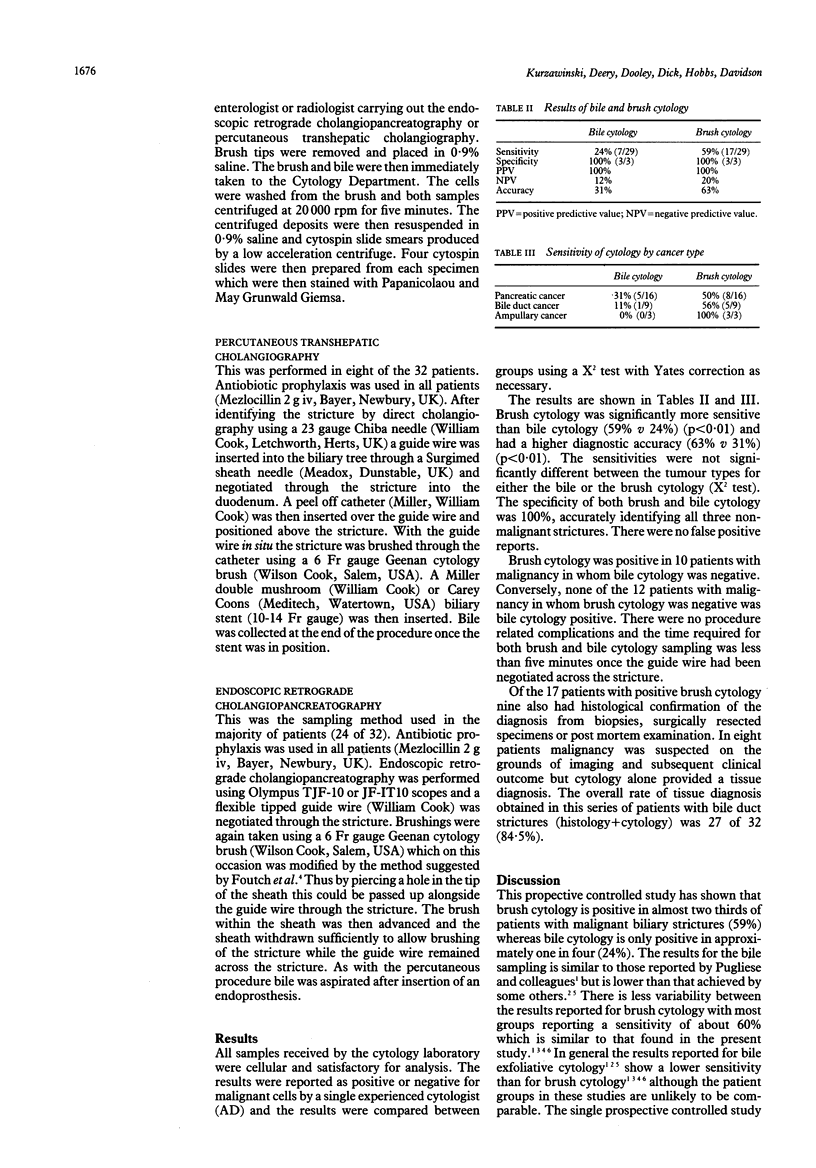Abstract
Imaging of biliary strictures may suggest malignancy but cytology can provide a tissue diagnosis. The aim of this study is to compare the diagnostic value of brush cytology and bile cytology. Thirty two patients (20 males, 12 females, median age 66 years, range 31-84) with biliary strictures at endoscopic retrograde cholangio pancreatography (24) or percutaneous transhepatic cholangiography (8) had bile cytology and brush cytology. Brushings were taken using a modified Geenan cytology brush (6 Fr gauge, Wilson Cook) passed alongside a guide wire placed through the stricture. Bile was aspirated after insertion of an internal/external catheter or an endoprosthesis. Bile and brushings were examined by one experienced cytologist (AD) and was reported as positive or negative for malignant cells. Twenty nine patients had malignant strictures. Sixteen were confirmed by histology and 13 had malignancy suggested by clinical follow up. Three patients had resection of histologically benign strictures. The overall sensitivity of brush cytology (17 of 29 positive, 59%) was significantly greater than bile cytology (seven of 29 positive, 24%) (p < 0.01) as was the diagnostic accuracy (63 v 31%, p < 0.01). None of the patients had positive bile cytology with negative brush cytology. There were no procedure related complications and the average sampling time once the guide wire had been inserted was less than five minutes. It is concluded that brush cytology is more sensitive than bile cytology and with the technique described is safe and rapid.
Full text
PDF


Selected References
These references are in PubMed. This may not be the complete list of references from this article.
- Cohan R. H., Illescas F. F., Newman G. E., Braun S. D., Dunnick N. R. Biliary cytodiagnosis. Bile sampling for cytology. Invest Radiol. 1985 Mar-Apr;20(2):177–179. doi: 10.1097/00004424-198503000-00015. [DOI] [PubMed] [Google Scholar]
- Foutch P. G., Harlan J. R., Kerr D., Sanowski R. A. Wire-guided brush cytology: a new endoscopic method for diagnosis of bile duct cancer. Gastrointest Endosc. 1989 May-Jun;35(3):243–247. doi: 10.1016/s0016-5107(89)72767-x. [DOI] [PubMed] [Google Scholar]
- Foutch P. G., Kerr D. M., Harlan J. R., Kummet T. D. A prospective, controlled analysis of endoscopic cytotechniques for diagnosis of malignant biliary strictures. Am J Gastroenterol. 1991 May;86(5):577–580. [PubMed] [Google Scholar]
- Iitsuka Y., Hiraoka H., Kimura A., Kodoh H., Koga S. Diagnostic significance of bile cytology in obstructive jaundice. Jpn J Surg. 1984 May;14(3):207–211. doi: 10.1007/BF02469569. [DOI] [PubMed] [Google Scholar]
- Pugliese V., Barone D., Saccomanno S., Conio M., Aste H., Santi L. Tissue sampling from the common bile duct through endoscopic retrograde cholangiopancreatography, endoscopic papillo(sphinctero)tomy and drainage in juxtapapillary malignancies. Surg Endosc. 1987;1(2):83–87. doi: 10.1007/BF00312690. [DOI] [PubMed] [Google Scholar]
- Rabinovitz M., Zajko A. B., Hassanein T., Shetty B., Bron K. M., Schade R. R., Gavaler J. S., Block G., Van Thiel D. H., Dekker A. Diagnostic value of brush cytology in the diagnosis of bile duct carcinoma: a study in 65 patients with bile duct strictures. Hepatology. 1990 Oct;12(4 Pt 1):747–752. doi: 10.1002/hep.1840120421. [DOI] [PubMed] [Google Scholar]
- Scudera P. L., Koizumi J., Jacobson I. M. Brush cytology evaluation of lesions encountered during ERCP. Gastrointest Endosc. 1990 May-Jun;36(3):281–284. doi: 10.1016/s0016-5107(90)71024-3. [DOI] [PubMed] [Google Scholar]
- Yip C. K., Leung J. W., Chan M. K., Metreweli C. Scrape biopsy of malignant biliary stricture through percutaneous transhepatic biliary drainage tracts. AJR Am J Roentgenol. 1989 Mar;152(3):529–530. doi: 10.2214/ajr.152.3.529. [DOI] [PubMed] [Google Scholar]


